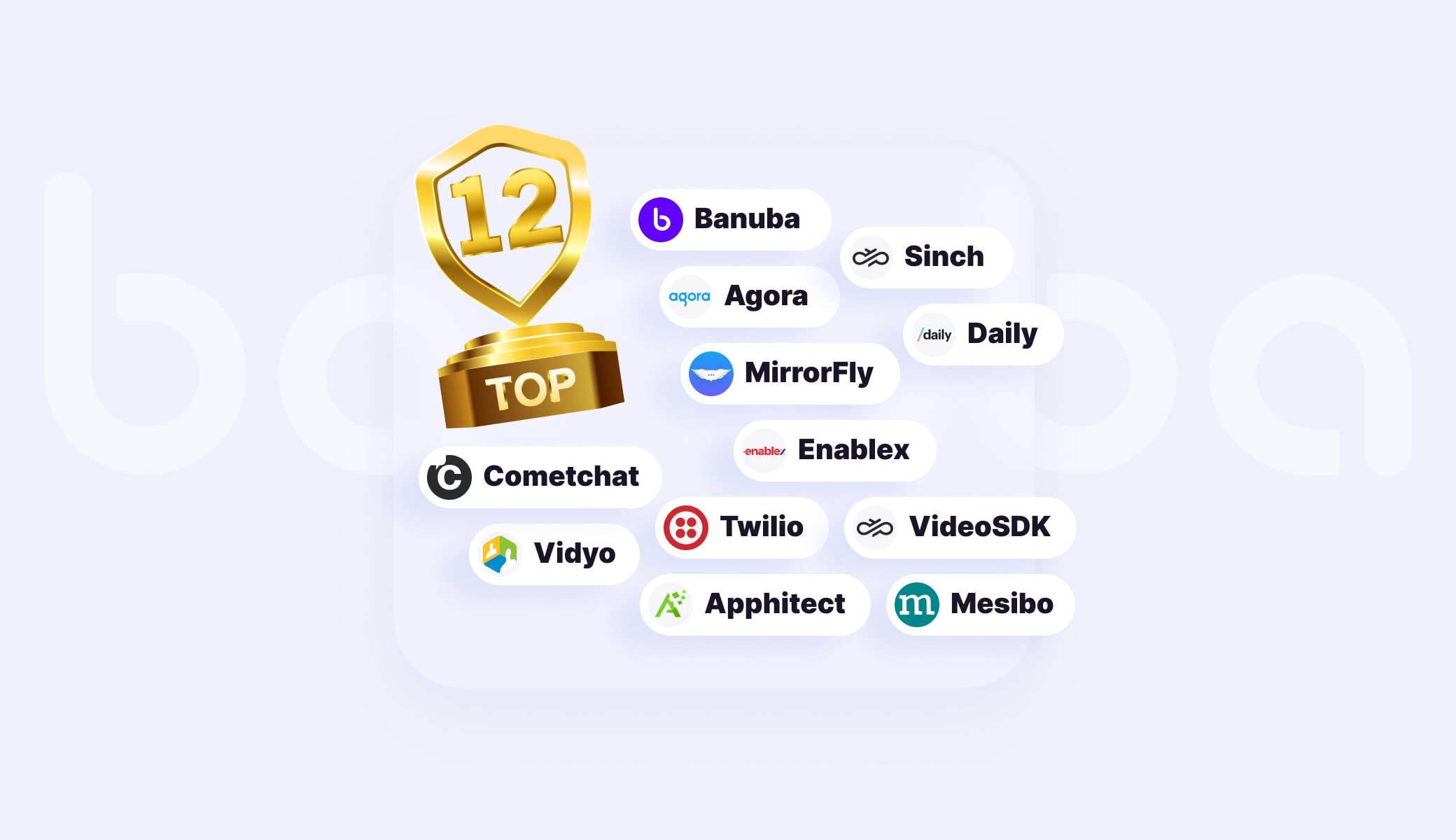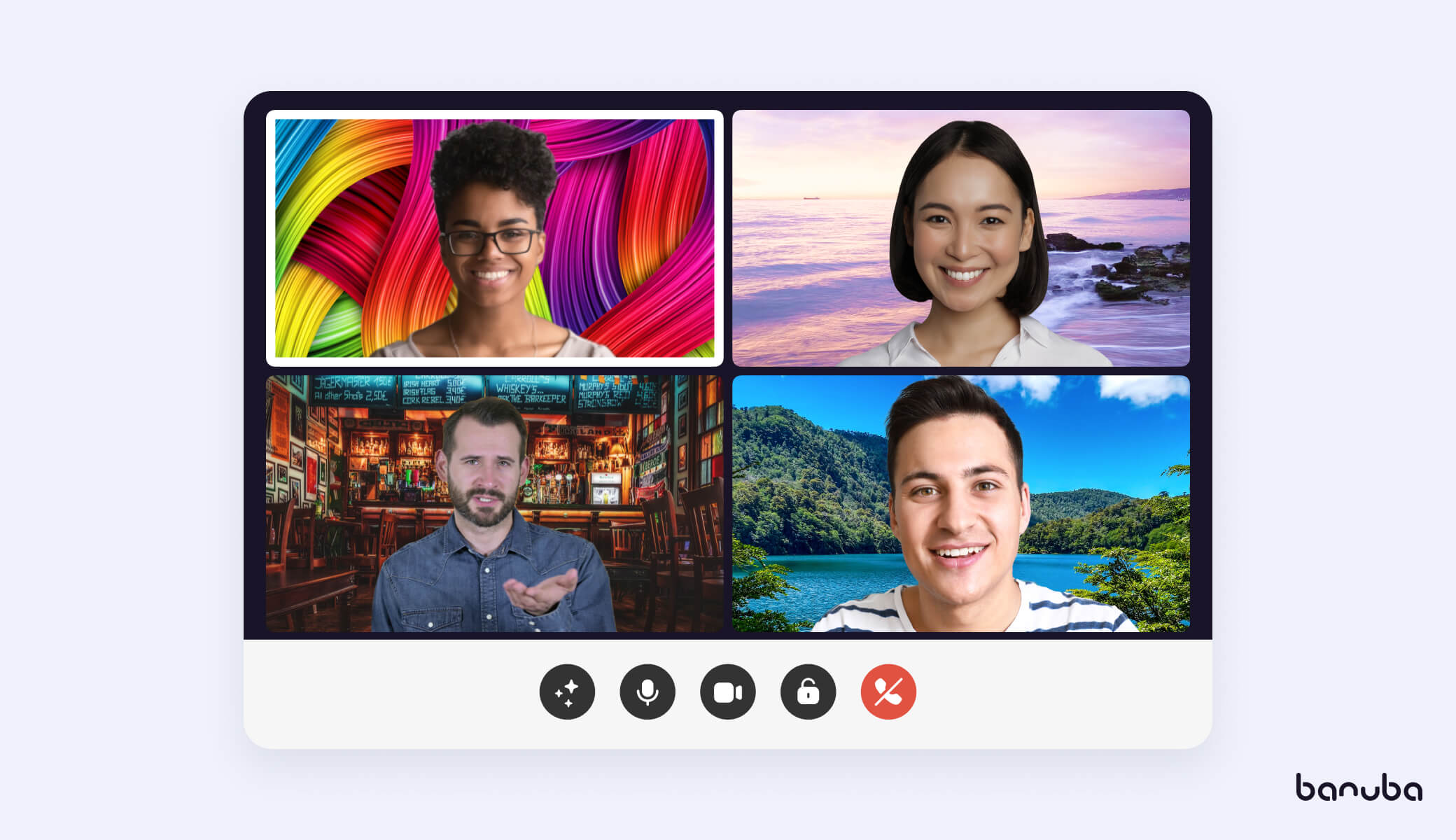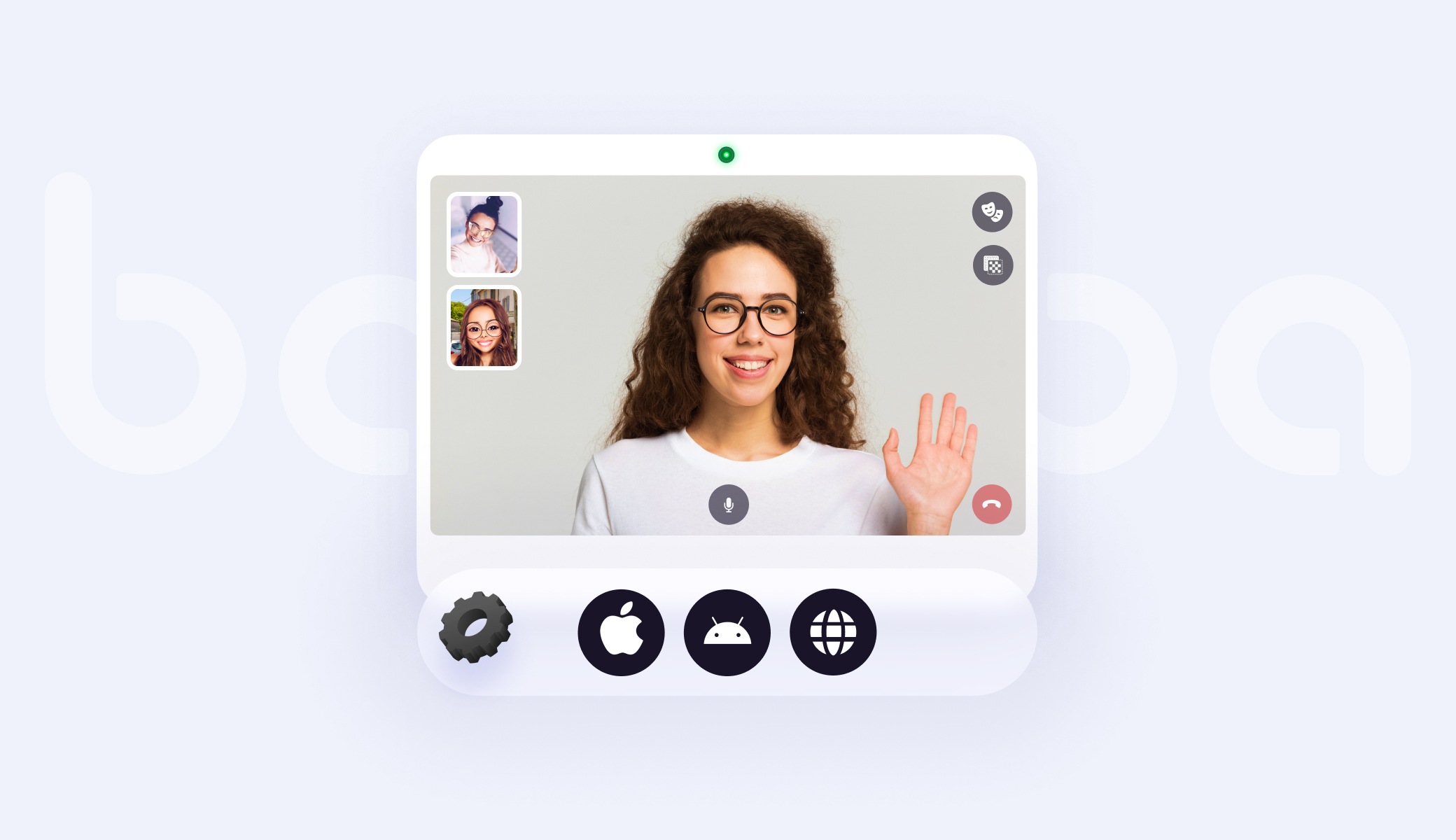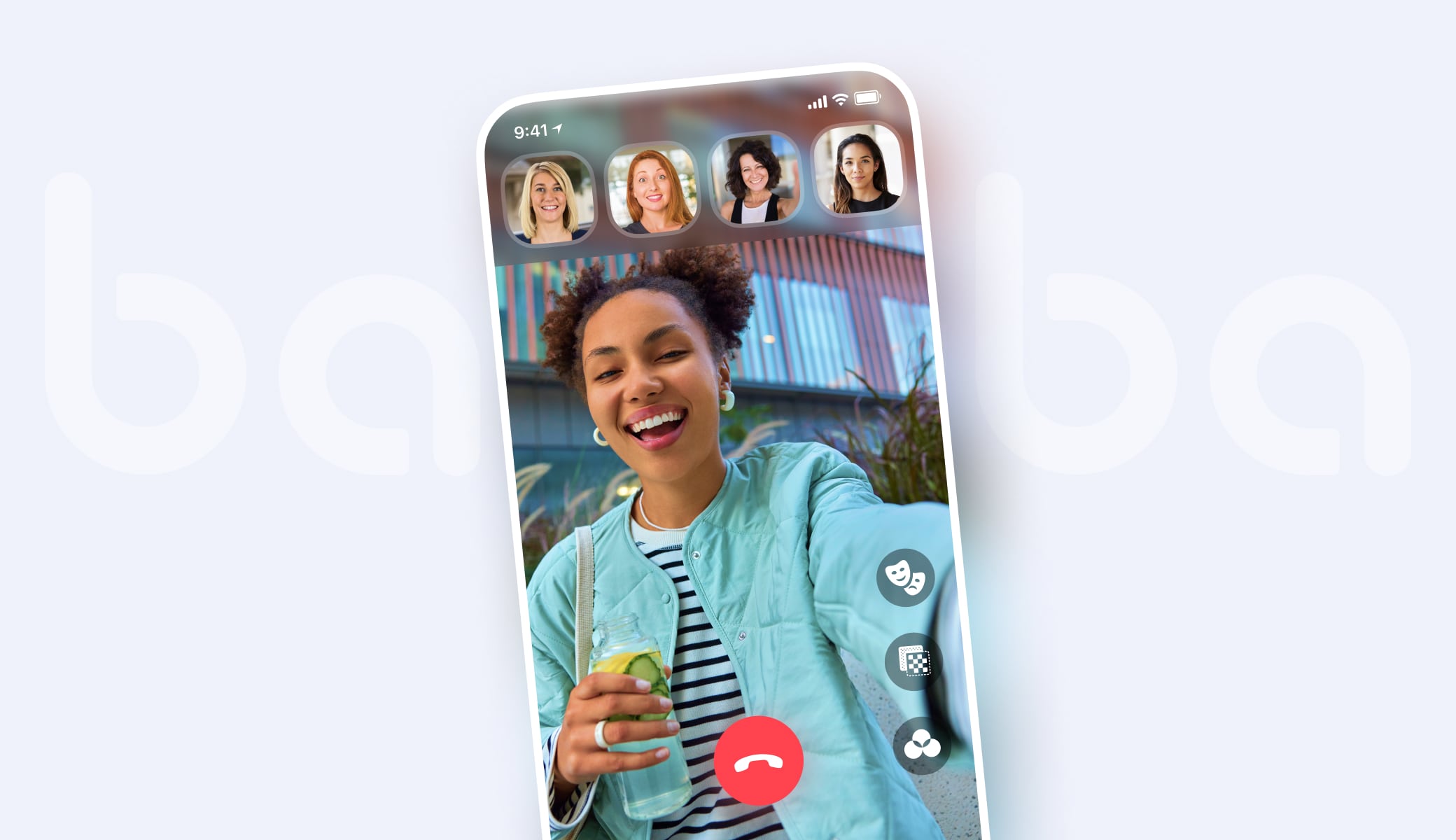[navigation]
What is a Video Conferencing SDK vs API?
A video conferencing SDK is a premade module that performs a set of relevant functions. For example, it might include the core functionality (video calling itself) or additional features (e.g. AR effects, background replacement, voice effects, etc.).
They are commonly used to decrease initial investment and time-to-market: developing the same technology from scratch is long and expensive.
In contrast, license payments for video chat SDKs are relatively low, and integrating one takes under a week - sometimes, less than a day.
A video conferencing API is a simple way to access the video calling feature set within a specific software. Think about a coffee machine: you don’t have to know the intricacies of its work to make a cappuccino, you just press a few buttons. An API is “buttons” of the software.
A video call SDK usually has an API that streamlines working with it.
Top 13 Video Conferencing APIs for Your Product
If you want to launch a video calling solution, improve your existing software, or add a video option to a chat app, these video conferencing APIs are worth your attention.
1. Banuba Face AR SDK
Banuba Face AR SDK is intended to make the video conferencing experience more engaging and safer through the use of augmented reality. It supports Android, iOS, Web, Unity, and desktop platforms.

The SDK is among the market leaders, being used by companies like Gucci, Samsung, and RingCentral.
Banuba Face AR SDK also has native integration with video effects API from Agora, allowing you to get an AR-powered communications software within a couple of days.
The core features include:
- AR face filters
- Background replacement
- 1000+ high-quality effects in an asset store
- Beautification: acne removal, skin smoothing, virtual makeup, eye bag removal, etc.
- Separate effects for faces on the screen
- 3D avatars that replace people and copy their facial expressions
- Effect usage analytics
- No user data gathering/storage
Pricing: depends on the number of features, apps, and platforms. Start a 14-day free trial to test all premium features in real time.
2. MirrorFly
MirrorFly is a highly scalable in-app video, voice, and chat SDK provider for developers and enterprises. Their self hosted chat solutions help businesses eradicate communication gaps between their teams and customers. They facilitate 150+ modern communication features that can be easily integrated into your preferred platforms.
Features:
- Live video calls and streaming
- Ultra-low latencies
- 99.999% uptime SLA
- Live broadcast recording
- Scalability
- Privacy compatible with HIPAA, GDPR, and OWASP
Pricing: SaaS: Easy offers Lifetime free chat; Essential starts at $299/month; Premium starts at $999/month. SaaP: A fully customizable SDK at a one-time license cost with white-label solutions.
3. Agora
Agora is a powerful video conference SDK for Android, iOS, Web, Unity, and desktop platforms. It fits casual and business video calls as well as live streaming apps. Agora SDK provides voice and video calling features but can be improved by installing extensions from its marketplace. These plugins include AR effects, voice effects, AI-powered content moderation, noise cancellation, etc.
Features:
- Video calls resolution up to 1080p
- AI-based antijitter
- Noise cancellation
- Screen sharing
- Supplemental enhancement information
- Compatible with Flutter and React Native.
 Background subtraction as a part of video conferencing SDKs
Background subtraction as a part of video conferencing SDKs
Pricing: from $3.99/1000 participant minutes. Free trial available.
4. Sinch
Sinch mostly targets Healthcare, Finance, and eCommerce industries. It offers video chat SDKs for iOS, Android, and JavaScript, focusing on mobile and web peer-to-peer communication.
Features:
- Video calls
- Voice-only calls
- Calls to phones
- SMS and MMS options
- Face filters

Pricing: on demand.
5. Daily
Daily offers a cross-platform video chat SDK for iOS, Android, Web, Unity, Unreal Engine, and desktop. It primarily targets eLearning, business communication, and the event industry. It boasts a global infrastructure that allows it to provide the lowest latency.
Features:
- HD video support
- Prerecorded video embedding
- “Raise your hand” button for eLearning
- Speech-to-text
- Up to 300 active participants
Pricing: from $9/mo, free plan available.
6. Enablex
Enablex provides video calling APIs under a PaaS (Platform-as-a-Service) model. It is compatible with web applications, as well as desktop and mobile platforms. In addition, it offers a web SDK for JavaScript and video conference SDKs for iOS, Android, React Native, Flutter, and Cordova.
Features:
- Automatic video quality adjustment
- Calls to phones
- Call analytics
- Relaying calls through the nearest servers
- Call encryption
- GDPR & HIPAA compliance
Pricing: from $0.004 per participant per minute. Free trial available.
7. Twilio
Twilio offers an API for video calling peer-to-peer or group chat experiences. It supports Web, iOS, and Android platforms.
Features:
- Virtual backgrounds
- Recording rules API (select whom to record)
- Video analytics
- Customizable UI
- HD video support
- GDPR compliance
Pricing: from $0.0015 per participant per minute. Free plan available.
 Video conferencing SDK with face filters increases engagement
Video conferencing SDK with face filters increases engagement
8. Cometchat
Cometchat serves all kinds of online communications, from text messaging to group video chats. Its SDKs are compatible with web and mobile video chat applications.
Features:
- Text translation in real time
- Customizable UI
- Collaborative whiteboards
- Automatic scaling to the number of users
- Call analytics
- HIPAA compliant
Pricing: from $139/mo. Free plan available.

9. VideoSDK
VideoSDK offers a video chat SDK for Android, iOS, Flutter, and React Native, as well as Web and desktop platforms. While it supports the common applications of video calls like business meetings and eLearning, it also has features for live shopping.
Features:
- Full HD video support
- Up to 5000 active participants on the call
- Routing through nearby servers to decrease latency
- Screen sharing
- Live streaming
- Customizable layout
Pricing: from $0.002 per participant per minute. Free trial available.
10. Apphitect
Apphitect provides text chat, as well as video and audio capabilities. It is compatible with the Web, iOS, and Android platforms.
Features:
- Up to 65K daily active users
- HD video support
- Video call recording
- Screen sharing
- Calls to phones
- Monetization of live streaming
Pricing: on demand.
11. Vidyo
Vidyo is compatible with mobile, web, and desktop platforms. It has video call SDKs, as well as a PaaS offering. Vidyo supports mobile platforms (including Xamarin and Electron), Web, and desktop.
Features:
- Up to 5K resolution support
- Livestream recording
- Video analytics
- Calls to phones
Pricing: on demand.
12. Mesibo
Mesibo offers video conferencing SDKs for mobile (incl. Xamarin and Flutter), Web, desktop, and Raspberry Pi.
Features:
- On-premise deployment
- 360-degree camera support
- Encrypted calls
- GDPR and HIPAA compliance
- Open-source
Pricing: $0.01 per user per month. Free for non-profits, as well as educational and research institutions.

Video Chat API/SDK Selection Checklist
Now that you have a list of possible video conference API solutions, here is the step-by-step checklist that will help you choose the best video call API for your business app.
1. Feature set
First and foremost, the video conference API/SDK has to provide the features that you need. Otherwise, it is pointless to choose it. Having more is useful. However, there should also be a balance between the costs and benefits. For example, if you want real-time video calling for a dating app, HIPAA compliance isn’t important, and paying for it is wasteful.
The must-have video call SDK features include:
- Peer-to-peer and group video calling
- Mute and camera toggle buttons
- Background replacement/blur
- Call access management
- AR masks/beautification.
 Background replacement - a must-have for a video conferencing SDK
Background replacement - a must-have for a video conferencing SDK
2. Performance
This parameter describes how well the SDKs run on specific platforms. This is what it includes:
- FPS. Frames-per-second is a simple metric to see how smooth a video looks. 30 FPS is par for the course but the higher the better.
- Stability. Apart from enough FPS, make sure the video performance is lag- and stuttering-free. The main causes of this are hardware-related (e.g. a slow camera or an underpowered CPU) but lack of optimization can also cause lags.
- CPU/GPU load. These metrics show much computing power from central and graphics processing does the software take. The lower the better, as it means less heating and battery power consumption.
- Long-term performance. Users should experience your video conferencing or chat application for a long-term period without performance breakdowns. So, benchmark potential video conferencing APIs for both short- (<30 min) and long-term (several hours) sessions to ensure smooth and stable performance in the long run.
3. Compatibility
This includes support for various devices, cross-platform mobile application frameworks, specific browsers, on-premise deployment, etc.
Regarding the devices, the more of them a video chat SDK supports - the larger target audience you can cover. For example, Banuba Face AR SDK supports 80% of Android smartphones and iPhones starting from model 5S.
For browsers, Chrome and Safari take about 85% of the market. On desktop, it is recommended to serve Edge as well. On mobile, working with Samsung Internet is good for gaining access to a larger user base.
Cross-platform framework support is a nice-to-have feature of a video calling API for your video app startup. Building a mobile video conferencing solution with React Native or Flutter can potentially decrease your development costs by up to 30%.
Also, on-premise deployment is important for companies that have stringent security requirements: nuclear power plants, medical centers, government agencies, etc.
4. Price and pricing model
This is the last step because you need to know what you are paying for before judging whether it’s worth the price. Paying $1000 for an ancient Datsun is too much. The same price for a 2-year-old Maserati is a bargain.
The pricing model is also important. For example, some companies price their video conference SDK for iOS/Android and Web per platform per year. This is beneficial for larger companies, as they can pay the same price for a million users or 100K. Others price per participant per minute. This is better suited for startups: as they don’t have many users yet, they can keep their costs down.
3 Ways to Integrate a Video Chat SDK Into Your App
Video conferencing API integration into an existing app or a project in development can be done quickly and painlessly. Here are 4 simple integration steps using Banuba Face AR SDK as an example. Once you’re all set with the integration, you’ll get a 14-day free trial to test all premium features up to their limits.
The first step is the same: getting the SDK and the trial token. To do it, just sent us a message.

Integrating a video call SDK - Android
This is where you should place the token:
[code]
BanubaClientToken.java
final class BanubaClientToken {
public static final String KEY = "YOUR_TOKEN_HERE";
private BanubaClientToken() {
}
}
[/code]
Then add the custom Maven repo to your build.gradle
[code]
allprojects {
repositories {
google()
mavenCentral()
maven {
name "GitHubPackages"
url "https://maven.pkg.github.com/sdk-banuba/banuba-sdk-android"
credentials {
username = "sdk-banuba"
password = "\u0067\u0068\u0070\u005f\u0033\u0057\u006a\u0059\u004a\u0067\u0071\u0054\u0058\u0058\u0068\u0074\u0051\u0033\u0075\u0038\u0051\u0046\u0036\u005a\u0067\u004f\u0041\u0053\u0064\u0046\u0032\u0045\u0046\u006a\u0030\u0036\u006d\u006e\u004a\u004a"
}
}
}
}
[/code]
That’s it.
Integrating iOS video conferencing API
Just add a custom source to your Podfile:
[code]
source 'https://github.com/sdk-banuba/banuba-sdk-podspecs.git'
[/code]
Then add Banuba Face AR SDK as a dependency:
[code]
target 'quickstart-ios-swift' do
use_frameworks!
pod 'BanubaSdk', '~> 1.4'
end
[/code]
And you’re done.
Integrating video conferencing API for website
For the web version, besides the token, you will get an archive. Unpack it, and put the client token into index.html.
[code]
// ...
const player = await Player.create({ clientToken: "PUT YOUR CLIENT TOKEN HERE" }) // <- put your Banuba Client token here as the hint suggests
// ...
[/code]
Then run npx live-server and open localhost:8080.
Why Banuba Video Conferencing SDK/API for Your Video Startup
Banuba Face AR SDK is a benefit for business and casual communication, as well as live streaming. This is why:
- Smooth beautification. People can make themselves look their best in a couple of clicks. This includes removing wrinkles, acne, and eye bags; adding virtual makeup, and even subtly modifying facial features. Beautification helps users be more confident on camera and saves them time.
- High-quality AR filters. Banuba’s AR masks and other effects are best-in-class. Many prospective customers choose this SDK specifically for its filters because they lead to a better user experience than competitors.
- Solid background replacement. After everyone started shifting to remote work, a lot of funny videos appeared with children and animals walking behind the user and embarrassing them. To avoid such situations, Banuba offers a background replacement feature. A person will remain perfectly visible while the rest of the image will be blurred or changed into a static picture, GIF, or video.
- Quick to install. Banuba Face AR videoconferencing SDK can be added to a mobile or web app with just a few lines of code.

Conclusion
There are plenty of video conferencing SDKs and APIs on the market. They differ in feature set, performance, compatibility, price, and pricing – the factors that matter in making the right choice.
A video conferencing API can be integrated in 3 simple and fast ways, saving a lot of money and time. And if you need to upgrade your video conferencing experience with high-quality AR effects, install Banuba Face AR SDK and get a 14-day free trial.



 Background subtraction as a part of video conferencing SDKs
Background subtraction as a part of video conferencing SDKs
 Video conferencing SDK with face filters increases engagement
Video conferencing SDK with face filters increases engagement Background replacement - a must-have for a video conferencing SDK
Background replacement - a must-have for a video conferencing SDK

